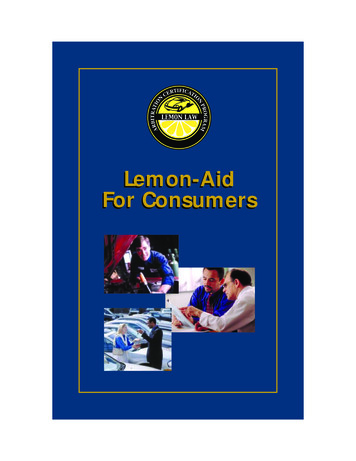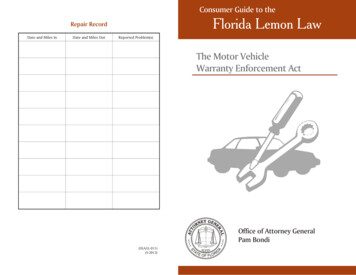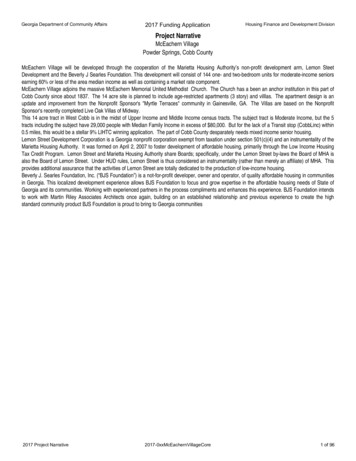
Transcription
Lemon-AidFor Consumers
Gray Davis, GovernorState of CaliforniaAileen Adams, SecretaryState and Consumer Services AgencyKathleen Hamilton, DirectorDepartment of Consumer AffairsCALIFORNIA DEPARTMENT OF CONSUMER AFFAIRS400 R Street, Sacramento, CA 94814 800-952-5210www.dca.ca.gov/acp
Lemon-AidFor ConsumersDear Consumer,Each year Californians scour car lots and the Internet to findcars, vans, SUVs, and pickups that fit their lifestyles. Withmore than 1.7 million new vehicles sold each year in thisstate, defective vehicles may be part of the mix. If you thinkyou got one of them, then this information about the LemonLaw, provided by the California Department of ConsumerAffairs, is just what you need.This booklet explains California’s Lemon Law in simpleterms. You should take the time to read through it right nowand then slip it into your new glove compartment. Hopefully,you won’t have to use the Lemon Law to get satisfaction, butit’s good to know it’s there if you need it.If you believe the car you purchased or leased meets thedefinition of a “lemon,” then the California Department ofConsumer Affairs, along with its Arbitration CertificationProgram, may be able to assist you. You can get moreinformation by logging onto the Department’s Web site atwww.dca.ca.gov or by calling (800)952-5210.Kathleen HamiltonDirector, California Department of Consumer Affairs
This booklet is available without charge bycalling the Department of Consumer Affairs’ toll-freetelephone number (800) 952-5210.This publication is also available online at theDepartment’s Web site www.dca.ca.gov/acp2002This publication is printed on recycled paper.4
ContentsIntroduction . 4Lemon Law Questions and Answers . 5The Lemon Law Arbitration Process . 11 Taking the First Step . 11 Organizing Your Paperwork . 12 Gathering Information . 12 Filing an Arbitration Application . 12 Presenting Your Case . 13 If You Disagree with the Arbitration Decision . 13California’s Certified Arbitration Programs . 14Vehicle Care Tips . 15If You Have Problems with Your Vehicle. 16Mileage Offset Formula . 17Where to Find Help . 18Legal Definition of a New Vehicle . 20Legal Guidelines — Lemon Law Presumption . 21Repair Record Summary . 225
California’sLemon LawIntroduction“I bought a new car so I’d have adependable car to rely on. But I spendmore time at the shop with my new carthan my old one!”— Irate ConsumerYou may have bought a new vehicle for anumber of reasons. One of the most com-mon reasons is dependability. A newvehicle should mean you don’t have to worry aboutbreakdowns, mechanical problems or safety. What ifyour new vehicle is giving you a headache, withrepeated visits to the dealer for service?California’s Lemon Law protects buyers and lesseesof vehicles with serious warranty defects that thedealer or manufacturer can’t repair. In some cases,you may be entitled to a replacement or refund foryour vehicle.This booklet answers questions about the LemonLaw, and provides information about the arbitrationprocess, record-keeping suggestions and sources ofadvice and assistance.6
Lemon LawQuestions and AnswersDoes California’s Lemon Law apply to my vehicle?The Lemon Law covers the following new and used vehiclesthat come with the manufacturer’s new vehicle warranty: Cars, pickup trucks and the chassis, chassis cab and thedrivetrain of a motor home. Vans and SUVs are coveredunder the Lemon Law. After-market parts, such as vanconversions, are not included. Dealer-owned vehicles anddemonstrators Vehicles purchased or leased forpersonal, family or householdpurposes Many vehicles purchased orleased primarily for business useThe Lemon Law DOES NOT apply to: Vehicles not registered under the California Vehicle Codebecause they are driven off-road; or Vehicles that have been abused(See the Legal Definition of a New Vehicle, page 20)What if the manufacturer or dealer can’t fix my vehicle?If the manufacturer or dealer can’t repair a serious warrantydefect in your vehicle after a “reasonable” number of attempts,the manufacturer must either: Replace the vehicle; or Refund its purchase price(Whichever you prefer)7
Lemon LawQuestions and AnswerscontinuedWhat is a “reasonable” number of repair attempts?There is no set number. However, California’s Lemon Lawcontains a guideline for determining when a “reasonable”number of repair attempts is presumed to have been made.This is called the “Lemon Law Presumption.”(See page 21 for an explanation of the Lemon Lawpresumption)When does the Lemon Law Presumption apply? Your vehicle must be one that’s covered as explained onpage 5 Your vehicle’s problems must be covered under themanufacturer’s warranty The problems must occur within 18 months of delivery,or within 18,000 miles on the odometer (whichevercomes first) The problems must substantially reduce the use, value orsafety of the vehicle to you; and The problems were not caused by abuseIf so, the Lemon Law Presumption applies if The manufacturer or dealer hasn’t fixed the same problem after four or more attempts; or Your vehicle’s problems could cause death or seriousbodily injury if it is driven and the manufacturer or dealerhas made at least two unsuccessful repair attempts; or The vehicle has been in the shop for more than 30 days(not necessarily in a row) for repair of any problemscovered by its warranty; and8LEMON-AID
If the warranty or owner’s manual requires you, you havenotified the manufacturer about the problems (It’s best to dothis in writing)If your vehicle meets these criteria, the Lemon Law presumesa reasonable number of repair attempts have been made andyou may be entitled to a replacement or a refund.Does there need to be four or more repair attempts ormore than 30 days out of service before I can takeadvantage of the Lemon Law?No, the manufacturer is obligated to repair serious warrantyproblems and has a “reasonable” opportunity to do so, evenwithout regard to the Lemon Law presumption.If the problem is very serious, a “reasonable” number ofattempts will ordinarily be fewer than four.Do I automatically get the choice of a new vehicle or arefund if my vehicle qualifies under the Lemon LawPresumption?No, the manufacturer can still prove in arbitration or in courtthat your vehicle does not qualify under the presumption. Theycan make any of these arguments: The manufacturer or dealer has not had a “reasonable”number of attempts to repair the problem; orFOR CONSUMERS9
Lemon LawQuestions and Answerscontinued The problem does not substantially affect the vehicle’s use,value or safety to you; or The problem was caused by abuse; or The problem has been repaired; or The problem never existed; or The problem is not covered by the warrantyIf the problem only happens once in awhile or is difficult todiagnose, an additional repair attempt may be considered“reasonable.” However, the law places the burden of provingthe need for an additional repair attempt on the manufacturer.The arbitrator or judge decides whether the manufacturer hashad a “reasonable” opportunity to make the needed repairs.Do I need to go to court for the Lemon Law to help me?No, in many cases the manufacturer of your vehicle may offera state-certified arbitration program (see page 14) that mayassist you to resolve your dispute. If so: You must request arbitration in order to claim the benefits ofthe Lemon Law Presumption; and You may accept or reject the arbitrator’s decisionWhat is arbitration?Arbitration is a free and relatively simple way of resolvingwarranty disputes. Both you and the manufacturer agree toallow a neutral third party (an arbitrator) decide whether areasonable number of repair attempts have been made and whatrelief will be ordered.10LEMON-AID
How will the arbitration process help me?Decisions in the arbitration process are madeon a case-by-case basis. Possible decisionsinclude: An additional repair attempt A replacement vehicle Your money back (a refund of the purchase price) Reimbursement for incidental expenses (towing, rental car,etc.); or NothingWhat are some advantages of arbitration? It is free, faster and less complicated than going to court Decisions are made within 40 days after the program getsyour application An arbitrator may request an inspection and written reporton your vehicle’s condition by an independent expert at nocost to you State-certified arbitration programs allow you to presentyour case orally. The oral presentation is open to the public,so you can bring a family member or friend for support You can accept or reject the decision. If you accept it, themanufacturer must accept it too If you reject the decision, you can still pursue your rights incourt. However, before you decide to sue, you shouldconsider consulting with an attorneyFOR CONSUMERS11
Lemon LawQuestions and AnswerscontinuedWhat other kinds of problems qualify forarbitration? The manufacturer failed to honor the terms of yournew car warranty; and You are still within your original warranty periodWhat problems do not qualify for arbitration? Sales disputes between consumers and dealers Equipment or defects not covered by themanufacturer’s new vehicle warranty Service contract or extended warranty issues After-market (non-manufacturer) parts Certain consequential damages Personal injury claims Cases in litigationI bought my used vehicle used with no warranty.Does California’s Lemon Law still apply to myvehicle?No, the Lemon Law applies only to disputes involving themanufacturer’s new vehicle warranty.(See page 18 for other sources of assistance)12LEMON-AID
TheLemon LawArbitration ProcessMany manufacturers offer an arbitration process thatis certified by the Department of ConsumerAffairs’ Arbitration Certification Program. Thesemanufacturers have agreed to comply with the arbitrator’sdecision, if the consumer accepts it.Taking the First StepHere are the first steps to take if you think you bought orleased a “lemon” vehicle:1. Read your warranty and owner’s manual.2. Tell the dealer about the problem. Make sure it’s fullydescribed on the repair order.3. Try to work with the dealer to resolve the problem.4. Keep copies of all repair orders and take notes of all yourconversations with dealer and any manufacturer representatives. If the problem isn’t quickly resolved, keep a logor notebook on the problems and warranty-related repairattempts. Include dates, occurrences, and other relatedinformation.5. Contact the manufacturer or its representative directly. Ifrequired by the warranty or owner’s manual, send themanufacturer a letter describing the problems that needfurther repair. Send that letter to the address shown inyour warranty or owner’s manual. Send it by certifiedmail and keep a copy and the certified mail receipt.FOR CONSUMERS13
The Lemon LawArbitration ProcesscontinuedOrganizing Your Paperwork Record and summarize warranty repairs in the order inwhich they occurred (use the form on page 22). Focus onthe problem(s) that affects the use, value, or safety of thevehicle to you. Make copies of the purchase order and finance/leaseagreement, all repair and service orders, any letters between you and the dealer or manufacturer, and any otherdocuments, such as signed statements, that might helpsupport your case. Do not use a highlighter pen on repairorders because it may blacken highlighted informationwhen photocopied.Gathering Information Contact the manufacturer and ask for any technical servicebulletins that might relate to your vehicle’s problem. Contact the National Highway Traffic Safety Administration (see page 19) and ask for any safety recall information. Find out if there has been a pattern of similarproblems with your vehicle model. To help prove the problem, get signed statements frommechanics and people who have ridden in your vehicle andexperienced the problem (for example, family or carpoolmembers). This is especially important if the problem onlyhappens once in awhile.Filing an Arbitration ApplicationYou may find an arbitration application in the informationpacket that came with the vehicle. It’s usually inside the glovebox. You can also get an application by calling themanufacturer’s arbitration program (see page 14).14LEMON-AID
When filling the application out,follow these steps: Clearly state what the problem isand what result you want fromarbitration. Review after filling it out to makesure it’s readable and complete. Before you send it, make a copy for your records.Presenting Your Case It is to your advantage to attend your hearing in person or bytelephone and present your case to the arbitrator. Organize and write down the main points of your problemand argument. Emphasize those problems that significantlyimpact the use, value, or safety of the vehicle to you. Minoradjustments are necessary to most new vehicles, and mentioning insignificant problems will divert attention from yourmain concerns. Rehearse your presentation. While the total number of days that a vehicle has been out ofservice can be important, arbitrators tend to focus on thoseproblems that still aren’t fixed. If the manufacturer hasrepaired some problems so that the vehicle conforms to theterms of the warranty, arbitrators generally will not order themanufacturer to replace or buy back the vehicle. Focus on theproblems that the dealer or manufacturer has not satisfactorily repaired. State what relief you want from the arbitrators. Remember, arbitration programs only address warranty repairissues and the expenses connected to them. To get any othermonetary awards, you must use the court system.If You Disagree with the Arbitration DecisionIf you aren’t satisfied with the arbitrator’s decision, you canreject it and either:1. File a court action against the manufacturer; or2. After an additional warranty repair attempt, re-file yourarbitration caseFOR CONSUMERS15
California’sCertifiedArbitrationProgramsSome manufacturers voluntarily seek certification of theirarbitration programs from the California Department ofConsumers Affairs’ Arbitration Certification Program. Thesestate-certified arbitration programs hear and make decisions aboutconsumers’ vehicle warranty problems.The Arbitration Certification Program monitors these programs tomake sure they meet state and federal standards. It investigatesconsumer complaints about their operations. It does not overturndecisions made by the state-certified programs.Certified ArbitrationProgramManufacturers RepresentedBBB Auto Line4200 Wilson Blvd., Suite 800Arlington, VA 22203-1838(800) 955-5100AM General (Hummer), General Motors(includes Buick, Cadillac, Chevrolet, GMC, Geo,Pontiac, Oldsmobile), Honda/Acura, Hyundai,Isuzu, Nissan/Infiniti, Porsche, Land Rover,Rolls Royce/Bentley, Saab, Saturn, Volkswagen/Audi, Workhorse Custom Chassis.Customer Arbitration Board*P.O. Box 1424Waukesha, WI 53186(800) 279-5343DaimlerChrysler (includes Dodge, Eagle,Jeep, and Plymouth)Dispute Settlement BoardP.O. Box 1424Waukesha, WI 53186(800) 688-2429Ford (includes Lincoln, Mercury)* Starting with the 2002 model year, DaimlerChrysler will notoffer a certified arbitration program for California consumers.16LEMON-AID
NOTE: Some manufacturers do nothave state-certified arbitrationprograms in California. Theyinclude: Alfa Romeo, BMW,Daewoo, Daihatsu, Ferrari, Jaguar,Kia, Lexus, Lotus, Mazda, MercedesBenz, Mitsubishi, Peugeot, Subaru,Suzuki, Toyota, Volvo and Yugo.Please check your owner’s manualand warranty materials to determineif your vehicle’s manufacturer offersan arbitration program.Vehicle Care TipsHere are basic tips to keep your new vehicle runningsmoothly: Don’t abuse your vehicle. Taking care of your vehicle willhelp it run longer. Warranty protection doesn’t apply todefects caused by misuse or abuse of your vehicle. Service and maintain your vehicle according to themanufacturer’s recommended schedule. Read and followthe warranty and owner’s manual. Keep a service record and save all repair orders andreceipts for maintenance performed on your vehicle.FOR CONSUMERS17
If You HaveProblems WithYour Vehicle When you take your vehicle in for service, completelydescribe the problem. Make sure the repair order showsthe problem(s) you’ve described, the mileage on theodometer at the time of repair and the dates your vehiclewas in the repair shop. Make sure that an authorized dealer performs all warranty repairs. You must give the manufacturer or an“authorized” repair facility a “reasonable” opportunity tomake needed repairs. Make sure that every repair attempt is documented with arepair order, even if no repairs are made. You may needthat documentation later. Keep copies of all service records and repair orders. If the problem isn’t being resolved, record all contactswith the dealer and any manufacturer’s representatives,noting the date and to whom you talked. Keep notesabout telephone calls, letters or personal conversationsabout your vehicle’s problems. Put together all of this ina binder or notebook. Notify the dealer immediately if a repair attempt is notsuccessful. Do not stop making vehicle payments.18
MileageOffsetFormula*If the arbitration decision awardsyou a replacement or refund foryour vehicle, the arbitrators maydeduct a mileage offset for your use ofthe vehicle prior to the first warrantyrepair attempt. When the mileage offsetapplies, California law requires the useof the following formula to calculatethe amount of the deduction:Purchase Price x Miles Driven By Buyer At First Repair Use Deduction120,000Here is an example:Price paid by consumer . 19,500Miles driven by buyer at first repair . 9,500 19,500 x 9,500 1,544 (mileage offset)120,000 19,500 minus 1,544 17,956 17,956 would be the amount you get back.* Source: California Civil Code Section 1793.2(d)(2)(C)19
Where to Find HelpProblems/Service NeededOrganization to Contact California’s LemonLaw ArbitrationDepartment of Consumer Affairs,Arbitration Certification Program401 S Street, Suite 201,Sacramento, CA 95814(916) 323-3406 or (800) 952-5210www.dca.ca.gov/acp Manufacturer’s ordealer’s failure tohonor the warranty Extended warrantyManufacturer or dealer, by certified mail(Check the owner’s manual for the addressto notify the manufacturer of warrantyrepair needs.) Service contractunderwritten by themanufacturerDepartment of Motor Vehicles (DMV)Bureau of Investigationswww.dmv.ca.gov(check the white pages of your telephone book)New Motor Vehicle Board1507 21st Street, Suite 330,Sacramento, CA 95814(916) 445-1888www.nmvb.ca.govLocal county consumer affairs office(check the white pages of your telephone book) Auto repair Repair invoicesDepartment of Consumer AffairsBureau of Automotive Repair(800) 952-5210www.smogcheck.ca.gov/ Dealer fraudNew Motor Vehicle Board (see above) MotorcyclesDMV Bureau of Investigations (see above) MotorhomesLocal District Attorney’s OfficeOffice of the Attorney General,Public Inquiry Unit1515 K Street, Sacramento, CA 95814(916) 322-3360 or (800) 952-5225www.caag.state.ca.us Sales disputes Used cars20LEMON-AID
Problems/Service Needed Safety complaint Recall informationOrganization to ContactNational Highway Traffic SafetyAdministration400 Seventh Street, SW,Washington, D C 20590www.nhtsa.dot.gov/Auto Safety Hotline: (800) 424-9393Center for Auto Safety1825 Connecticut Ave., NW, Suite 330Washington, D C 20009(202) 328-7700www.autosafety.org Lemon LawattorneysCheck your yellow pages at the beginningof the “attorneys” listing for lawyer referralservices or call the California State Bar at(415) 538-2000 to get the name of thecertified lawyer referral service nearest you.www.calbar.org Other Lemon LawinformationConsumers for Auto Reliability andSafety (CARS)926 J Street, Suite 523Sacramento, CA 95814(530) 759-9440www.carconsumers.com/ Extended servicecontractsDepartment of Insurance770 L Street, Sacramento, CA 95814(800) 927-4357www.insurance.ca.gov/FOR CONSUMERS21
Legal Definitionof a New Vehicle**The Lemon Law covers new motor vehicles including: A new vehicle bought or used primarily for personal,family, or household purposes A new vehicle with a gross vehicle weight under10,000 pounds bought or used primarily for businesspurposes (provided the owner or business has nomore than five vehicles registered in California) The chassis, cab, and the propulsion portions of amotor home A dealer-owned vehicle, a “demonstrator” or othermotor vehicle sold with a manufacturer’s new carwarranty (such as a used vehicle) Purchased and leased vehicles“New Motor Vehicle” does not include: Any portion of the motor home designed, used ormaintained primarily for human habitation, or A motorcycle or a motor vehicle which is not registered under the Vehicle Code because it is to beoperated or used exclusively as an off-road vehicle** Source: California Civil Code Section 1793.22(e)22
Legal GuidelinesThe Lemon Law Presumption***The Lemon Law presumes that a vehicle is a “lemon”if the following criteria are met within 18 months ofdelivery to the buyer or lessee or 18,000 miles onthe vehicle’s odometer, whichever comes first:1. The manufacturer or its agents have made four or moreattempts to repair the same warranty problem, or thevehicle has been out of service for more than 30 days(not necessarily all at the same time) while beingrepaired for any number of warranty problems; or2. The manufacturer or its agents have made two or moreattempts to repair a warranty problem that results in acondition that is likely to cause death or serious bodilyinjury if the vehicle is driven; and3. The problems are covered by the warranty, substantiallyreduce the vehicle’s use, value or safety to the consumer,and are not caused by abuse of the vehicle; and4. If required by the warranty materials or by the owner’smanual, the consumer has directly notified the manufacturer about the problem(s), preferably in writing. Thenotice must be sent to the address shown in the warrantyor owner’s manual.If these criteria are met, the Lemon Law presumes thebuyer or lessee is entitled to a replacement vehicle or arefund of the purchase price. However, the manufacturermay show that the criteria have not been met (for example,because the problems are minor) and that the buyer orlessee is therefore not entitled to a replacement vehicle orrefund.*** Source: California Civil Code Section 1793.22(b)23
Repair Record SummaryDate24MileageRepair Order No.Days Out of SeviceLEMON-AID
Recording the information from your service repairorders in chronological order on a chart like this willhelp you organize your information.ProblemRepairs MadeFOR CONSUMERS25
It Only Takes a Little Energyto Save a Lot Even when you’re away from home in your car, there’s a lotyou can do to save energy, money and Flex Your Power: Set your heater lower in the winter andair conditioner higher in the summer In the winter, keep your house at 68ø or lower when you’rehome, and set your thermostat to 55 when away or asleep. In the summer, keep your house at 78 or higher whenyou’re home, and set your thermostat to 85 or off whenyou’re away. And, try cooling off with fans instead of airconditioning Use appliances after 7 P.M. Help prevent rolling blackouts by using large appliances,such as washing machines and dishwashers after 7 P.M. One fridge is enough You can save 150 or more a year by unplugging your secondrefrigerator Don’t light an empty room Compact fluorescent bulbs save a lot. Turning out lightssaves even more. Don’t forget to turn off computers andother electronic equipment when you’re not using them. Use appliances wisely Do laundry on the cold water setting. Line dry clotheswhenever you can. Run your dishwasher only when it’s full,and air-dry the dishes.CALIFORNIA DEPARTMENT OF CONSUMER AFFAIRS400 R Street Sacramento, CA 958141-866-YOUR PWR-968-7797www.flexyourpower.ca.gov
401 S Street, Suite 201 Sacramento, CA 95814ARBRITRATION CERTIFICATION PROGRAMCalifornia Department of Consumer Affairs
The Lemon Law covers the following new and used vehicles that come with the manufacturer's new vehicle warranty: Cars, pickup trucks and the chassis, chassis cab and the drivetrain of a motor home. Vans and SUVs are covered under the Lemon Law. After-market parts, such as van










